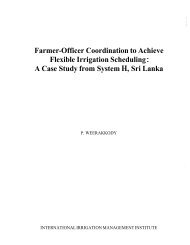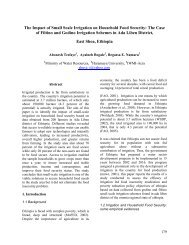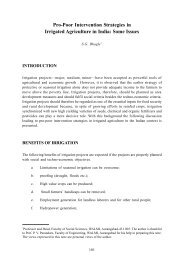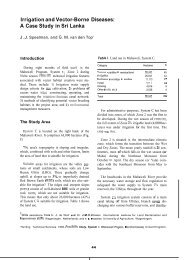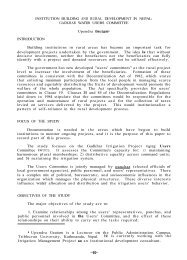WATER POVERTY IN THE NORTHEASTERN HILL REGION (INDIA)
WATER POVERTY IN THE NORTHEASTERN HILL REGION (INDIA)
WATER POVERTY IN THE NORTHEASTERN HILL REGION (INDIA)
Create successful ePaper yourself
Turn your PDF publications into a flip-book with our unique Google optimized e-Paper software.
<strong>WATER</strong> <strong>POVERTY</strong> <strong>IN</strong> <strong>THE</strong> NOR<strong>THE</strong>ASTERN <strong>HILL</strong> <strong>REGION</strong> (<strong>IN</strong>DIA): POTENTIAL ALLEVIATION THROUGH MULTIPLE-USE <strong>WATER</strong> SYSTEMS4.1. Development of Multiple-Use Water Schemes in Nepal HillsIn order to address the household water need for production and domestic use, InternationalDevelopment Enterprises (IDE), with some modifications to the conventional piped water systemsfor the hilly villages, designed a new scheme. The scheme includes one storage tank (Thai Jar) ofabout 3,000 liters for drinking water and the overflow from this tank is collected in an undergroundtank of about 10,000 liters for irrigation through off-takes at farmer’s field. The design was testedin 2001 in Palpa (Nepal) and was introduced to other IDE implemented projects as well, whichwas known as ‘hybrid’ system which now is known as multiple-use water schemes (MUS) in thehills of Nepal. One of the primary objectives of the introduction of new technology was to increasehousehold income through sale of the surplus agricultural produce in the market. The project laidemphasis on encouraging households in the community to produce cash crop, mainly the vegetables.Since vegetables are perishable items, the market linkage along with collection centres was importantin development of this technology. The goal of the MUS Project is to explore ways to improve poorpeople’s livelihood, reduce unpaid workloads, alleviate poverty and enhance gender equity throughmore productive use of small-scale water supplies in hill districts of Nepal (Adhikary 2009). Theworks carried out under the project show that these small-scale schemes have several advantages (Pantet al 2006):i.ii.iii.iv.v.vi.Cost effective in supplying water to remote areas.Flexibility in its adoption in different locations.Water supply both for household use and for micro-irrigation of high value crops.Adopted technologies are suitable for the difficult terrain of hilly regions.Low construction and maintenance costs and relatively short construction period (less than 3months on an average)Low pay back period (less than 2 years) with low per household investments.vii. Reduced drudgery for women and children for water collection.viii. Improved sanitation and hygiene practices.ix.x.xi.Reduced need for expensive storage tanks.Significant financial incentives for farmers to install and maintain due to income from high valuecash crops.High level of community participation in scheme constructioon and operation and maintenance.In addition, there are significant benefits from household water supplies, which reduce drudgery andunproductive use of household labor, particularly of women and children, and improved public health.The project has also developed guidelines illustrating the process for MUS implementation based on a5-year experience (Mikhail and Yoder, 2009).28



